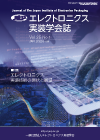Volume 25, Issue 1
Displaying 1-34 of 34 articles from this issue
- |<
- <
- 1
- >
- >|
Preface
-
Article type: Preface
2022 Volume 25 Issue 1 Pages P1
Published: January 01, 2022
Released on J-STAGE: January 01, 2022
Download PDF (182K)
Special Articles / Electronics Packaging Technology: The Current Status and Perspective
-
Article type: Special Articles
2022 Volume 25 Issue 1 Pages 1
Published: January 01, 2022
Released on J-STAGE: January 01, 2022
Download PDF (275K) -
Article type: Special Articles
2022 Volume 25 Issue 1 Pages 2-8
Published: January 01, 2022
Released on J-STAGE: January 01, 2022
Download PDF (1533K) -
Article type: Special Articles
2022 Volume 25 Issue 1 Pages 9-11
Published: January 01, 2022
Released on J-STAGE: January 01, 2022
Download PDF (586K) -
Article type: Special Articles
2022 Volume 25 Issue 1 Pages 12-16
Published: January 01, 2022
Released on J-STAGE: January 01, 2022
Download PDF (1114K) -
Article type: Special Articles
2022 Volume 25 Issue 1 Pages 17-20
Published: January 01, 2022
Released on J-STAGE: January 01, 2022
Download PDF (787K) -
Article type: Special Articles
2022 Volume 25 Issue 1 Pages 21-24
Published: January 01, 2022
Released on J-STAGE: January 01, 2022
Download PDF (666K) -
Current Status and Future Perspective of Electronics Components & Electronics Packaging TechnologiesArticle type: Special Articles
2022 Volume 25 Issue 1 Pages 25-32
Published: January 01, 2022
Released on J-STAGE: January 01, 2022
Download PDF (1948K) -
Article type: Special Articles
2022 Volume 25 Issue 1 Pages 33-38
Published: January 01, 2022
Released on J-STAGE: January 01, 2022
Download PDF (983K) -
Article type: Special Articles
2022 Volume 25 Issue 1 Pages 39-46
Published: January 01, 2022
Released on J-STAGE: January 01, 2022
Download PDF (1354K) -
Article type: Special Articles
2022 Volume 25 Issue 1 Pages 47-53
Published: January 01, 2022
Released on J-STAGE: January 01, 2022
Download PDF (1935K) -
Article type: Special Articles
2022 Volume 25 Issue 1 Pages 54-59
Published: January 01, 2022
Released on J-STAGE: January 01, 2022
Download PDF (2317K) -
Article type: Special Articles
2022 Volume 25 Issue 1 Pages 60-63
Published: January 01, 2022
Released on J-STAGE: January 01, 2022
Download PDF (858K) -
Article type: Special Articles
2022 Volume 25 Issue 1 Pages 64-67
Published: January 01, 2022
Released on J-STAGE: January 01, 2022
Download PDF (430K) -
Article type: Special Articles
2022 Volume 25 Issue 1 Pages 68-71
Published: January 01, 2022
Released on J-STAGE: January 01, 2022
Download PDF (733K) -
Article type: Special Articles
2022 Volume 25 Issue 1 Pages 72-79
Published: January 01, 2022
Released on J-STAGE: January 01, 2022
Download PDF (1655K) -
Article type: Special Articles
2022 Volume 25 Issue 1 Pages 80-85
Published: January 01, 2022
Released on J-STAGE: January 01, 2022
Download PDF (624K) -
Article type: Special Articles
2022 Volume 25 Issue 1 Pages 86-91
Published: January 01, 2022
Released on J-STAGE: January 01, 2022
Download PDF (1169K) -
Article type: Special Articles
2022 Volume 25 Issue 1 Pages 92-95
Published: January 01, 2022
Released on J-STAGE: January 01, 2022
Download PDF (551K) -
Article type: Special Articles
2022 Volume 25 Issue 1 Pages 96-100
Published: January 01, 2022
Released on J-STAGE: January 01, 2022
Download PDF (624K) -
Article type: Special Articles
2022 Volume 25 Issue 1 Pages 101-102
Published: January 01, 2022
Released on J-STAGE: January 01, 2022
Download PDF (420K)
Technical Paper
-
Article type: Special Articles
2022 Volume 25 Issue 1 Pages 103-110
Published: January 01, 2022
Released on J-STAGE: January 01, 2022
Advance online publication: October 04, 2021Download PDF (1493K) -
Article type: Special Articles
2022 Volume 25 Issue 1 Pages 111-122
Published: January 01, 2022
Released on J-STAGE: January 01, 2022
Advance online publication: December 03, 2021Download PDF (1934K) -
Article type: Special Articles
2022 Volume 25 Issue 1 Pages 123-132
Published: January 01, 2022
Released on J-STAGE: January 01, 2022
Advance online publication: December 09, 2021Download PDF (1757K) -
Article type: Technical Paper
2022 Volume 25 Issue 1 Pages 133-140
Published: January 01, 2022
Released on J-STAGE: January 01, 2022
Advance online publication: December 03, 2021Download PDF (1375K)
Tutorial Series-Next Generation Packaging Technology of Power Electronic Devices Course / (5)
-
Article type: Tutorial Series
2022 Volume 25 Issue 1 Pages 141-144
Published: January 01, 2022
Released on J-STAGE: January 01, 2022
Download PDF (1043K)
Report
-
Article type: Report
2022 Volume 25 Issue 1 Pages 145
Published: January 01, 2022
Released on J-STAGE: January 01, 2022
Download PDF (368K)
Report
-
Article type: Special Articles
2022 Volume 25 Issue 1 Pages 147-148
Published: January 01, 2022
Released on J-STAGE: January 01, 2022
Download PDF (480K)
Announcement, Contents, etc.
-
Article type: Announcement
2022 Volume 25 Issue 1 Pages 146
Published: January 01, 2022
Released on J-STAGE: January 01, 2022
Download PDF (211K) -
Article type: Special Articles
2022 Volume 25 Issue 1 Pages 150
Published: January 01, 2022
Released on J-STAGE: January 01, 2022
Download PDF (282K) -
Article type: Announcement
2022 Volume 25 Issue 1 Pages A11-
Published: January 01, 2022
Released on J-STAGE: January 01, 2022
Download PDF (254K) -
Article type: Announcement
2022 Volume 25 Issue 1 Pages C11
Published: January 01, 2022
Released on J-STAGE: January 01, 2022
Download PDF (221K) -
Article type: Announcement
2022 Volume 25 Issue 1 Pages C12
Published: January 01, 2022
Released on J-STAGE: January 01, 2022
Download PDF (161K) -
2022 Volume 25 Issue 1 Pages I11-
Published: January 01, 2022
Released on J-STAGE: January 01, 2022
Download PDF (511K)
- |<
- <
- 1
- >
- >|
